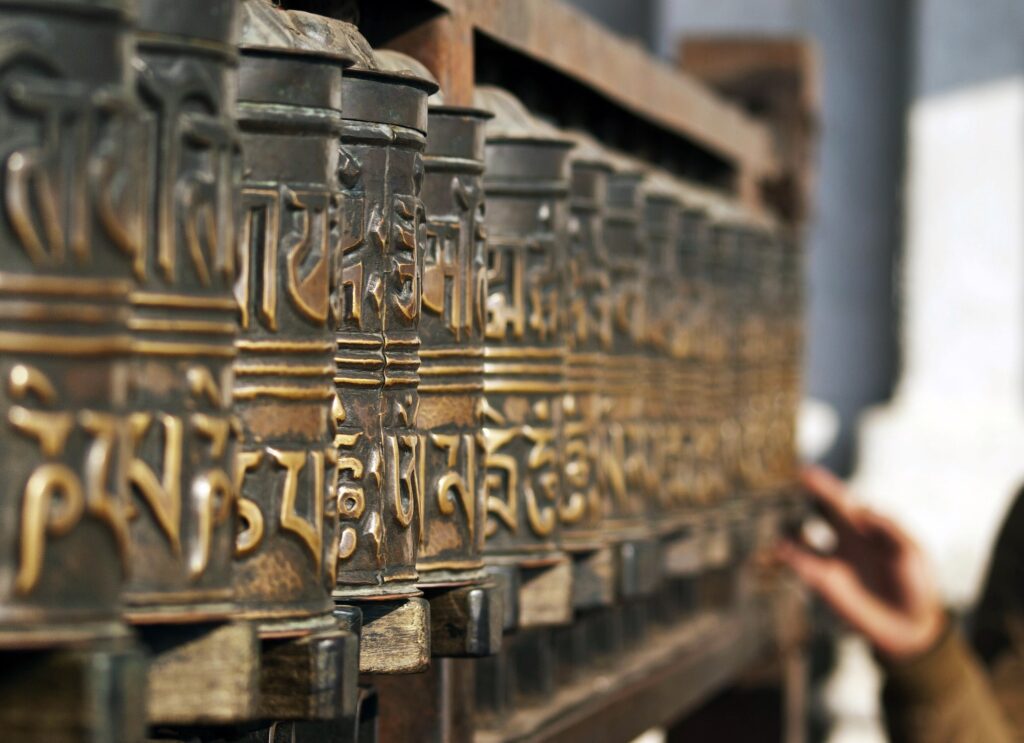Meditating with the right mantra can be a determining factor in the quality of your practice. If you’re going to repeat the same mantra over and over in every meditation session, you’ll want to rely on a sound or phrase that works. Just like you wouldn’t use a hammer to build a watch, or a spoon to fix a car, your mantra should be the right kind of tool to help you enjoy a restful meditation.
Unlike other meditation practices that recommend personal or beginner-friendly mantras, Vedic Meditation mantras are different. They aren’t chosen by you; instead, they are passed down through a long-standing oral tradition, from teacher to student. These mantras aren’t written down; they are kept private by the Vedic Meditation teachers (Initiators), who know which specific mantras work best for each meditator.
In order to understand why Vedic Meditation mantras are unique, let’s discuss what mantras are, and their function specifically in the Vedic tradition.
What is a mantra?
Though the common concept of mantras includes everything from inspiring phrases and quotes to chanted sounds in other languages, the original meaning of a mantra comes from its Sanskrit root. The word man is Sanskrit for mind. It’s a shortened form of the word manas, which means mind. Tra means conveyance, like a vehicle. Mind and vehicle, man-tra, means ‘a vehicle of the mind.’
The mantras that come from the Vedic tradition are the only true mantras, all mantras come from the Vedic tradition. When someone refers to an English word or phrase as a mantra, they are using the term colloquially and not according to its true Sanskrit meaning.
While simple mantras for meditation, laden with intention, can help focus the mind or bring about certain sensations, they won’t have the same deep effect as mantras given to you by an experienced Vedic Meditation teacher. If you want to experience the full benefits of Vedic Meditation, it’s essential to learn Vedic Meditation from an experienced teacher.

Are there different kinds of mantras?
There are hundreds of thousands of mantras, and they are all preceded by an adjective. For example, a Vidya-Mantra communicates a concept. It’s a mantra that has meaning and intent. Those kinds of mantras do not create rest in the body, since they bring up thinking. Mantras that make use of meaning cause the mind to be fixated on the level of meaning. Fixation on the level of meaning will not allow the mind to move to subtler and subtler layers of awareness.
For the purpose of learning how to transcend thought, or to go beyond our regular thinking process to experience the source of thoughts, we require a different kind of mantra.
What kind of mantra can move beyond thought?
Neuroscientists have shown that our minds experience 60,000-100,000 thought events on any given day. Each of these thoughts is made up of energy and intelligence. We can measure the output of the energy of a thought with an EEG machine. Thoughts require electrical impulses. Thought requires energy, and it isn’t a random explosion of energy. It’s specific, it’s about something. That’s what tells us that thought requires intelligence.
Given the vast number of thoughts we experience, it’s natural to wonder: Where do these thoughts come from? While external stimuli can trigger thoughts, the source of thought is consciousness itself.
The Source of Thought
The source of thought is referred to in Sanskrit by many names. One of the names for the consciousness beyond thought is Samadhi, which is a state of being aware inside without thinking.
Typically our consciousness is filled with memories, thoughts, and images. If we want to access the screen beyond the projections and activities of the mind, or if we want to experience consciousness in its purest state, we must move beyond thought. This place beyond thought is Being, it’s the fountainhead of thought. It is a supreme, contented, inner state of bliss and quietness.
Bliss in Samadhi is not happiness or ecstasy. It’s a supreme inner contentedness wherein the mind is so satisfied that it no longer produces thoughts. In fact, the reason the mind produces thoughts is to create more happiness or bliss. The mind creates thoughts out of dissatisfaction.
Vedic Meditators use a specific kind of mantra that will guide the mind beyond thought to the place of deep contentment known as Samadhi.

The Bija Mantra
Bija mantras are a very specific class of mantras with only one purpose: to de-excite the mind. These mantras take the mind from the conscious thinking level to the transcendent state. Bija mantras have no intended meaning. They do not work on the level of meaning. They work on the level of vibratory quality or resonant quality.
Different people are made up of different bundles of vibrations. In the science of Vedic Meditation, the instructor will select a Bija mantra which has characteristics similar to the student’s vibratory state. That way, with each pulsation of the mantra in meditation, the mantra will be charming for the mind, and it will effortlessly become subtler and quieter. The mind has a natural tendency to move toward greater happiness, so it will naturally follow the mantra to a more quiet and contented place.
As the mind draws more inward, it follows the mantra until the inner sound is nearly imperceptible. Finally the mantra disappears and the mind is left with no mantra and no thought replacing it. That is the state in which our mind has become one with the unified field of consciousness. That is the state in which we can experience oneness with all that is, or oneness with the source of thought.
How to Choose a Mantra for Meditation
If you search and ask even the most practiced meditations, you won’t find a list of mantras and their benefits in the Vedic tradition. The best way to choose the correct Bija Mantra for you is to trust a trained Vedic Meditation instructor. There are several hundred initiators trained by Thom, who know how to assign Bija Mantras correctly. They can also teach you how to use the mantra to reach the state of Samadhi.
How do initiators learn all of the mantras?
Anyone who has learned Vedic Meditation can attend Initiator Training with Thom. Over a 12 week period, Thom shows the methodology that allows you to select the correct mantra for each student and train them to use the mantra correctly.
To receive your own mantra and begin this journey, sign up for an Intro Talk and register for the Learn to Meditate course. You will experience first hand the power of the Bija Mantra to take your mind beyond thought and your body into a state of deep rest.
